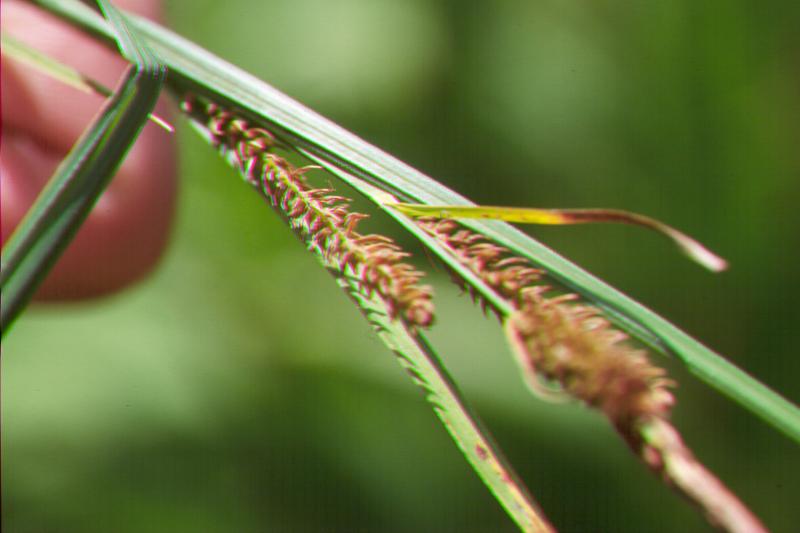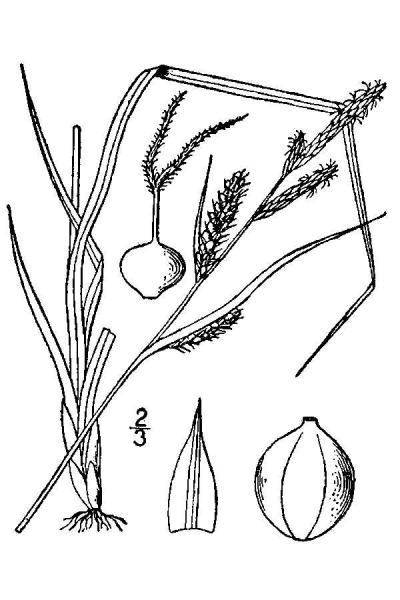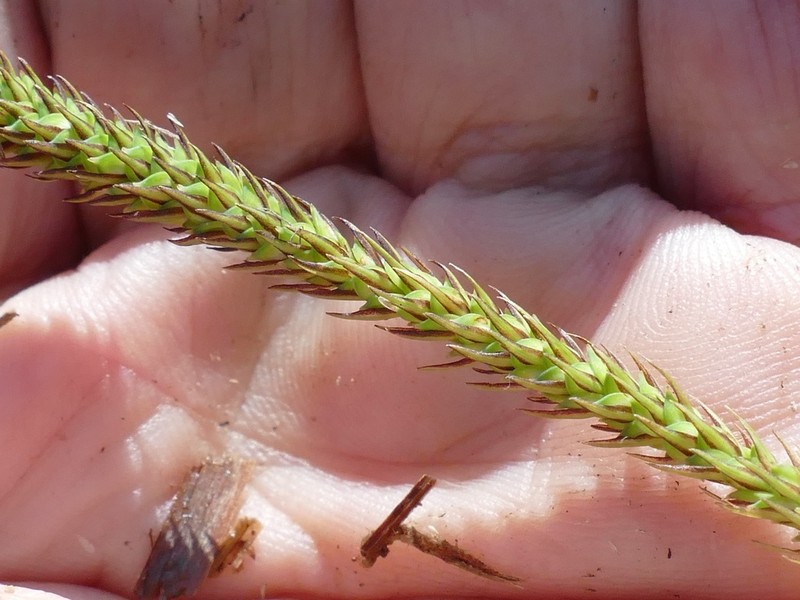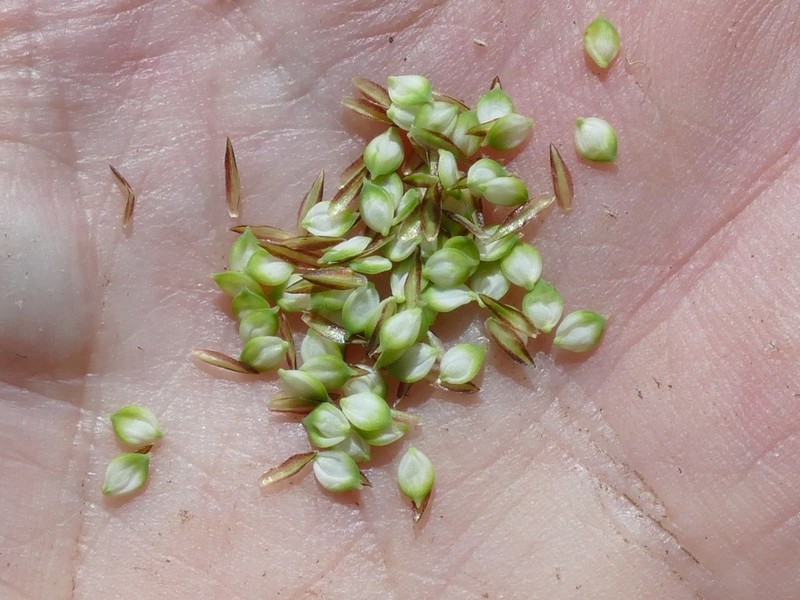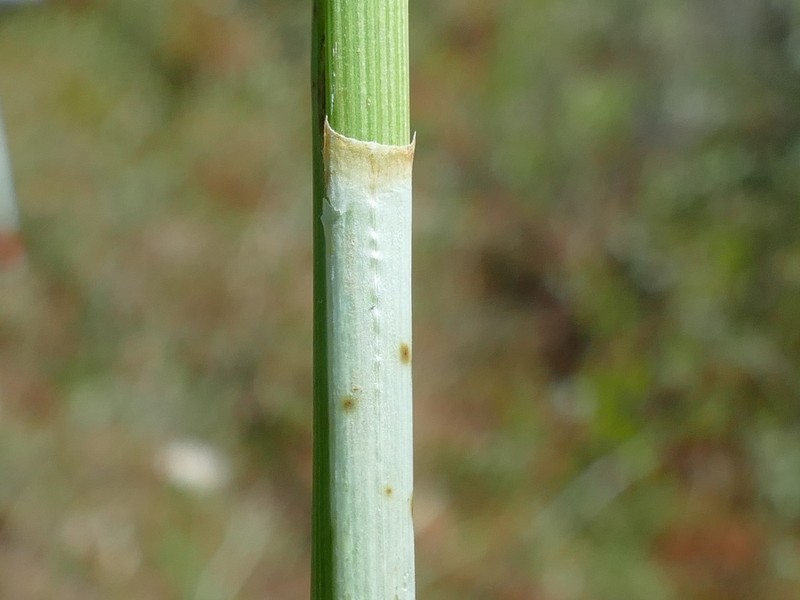Cloud Sedge
Carex haydenii Dewey
- Class
- Monocotyledoneae (Monocots)
- Family
- Cyperaceae (Sedge Family)
- State Protection
- Threatened
Listed as Threatened by New York State: likely to become Endangered in the foreseeable future. For animals, taking, importation, transportation, or possession is prohibited, except under license or permit. For plants, removal or damage without the consent of the landowner is prohibited.
- Federal Protection
- Not Listed
- State Conservation Status Rank
- S2
Imperiled in New York - Very vulnerable to disappearing from New York due to rarity or other factors; typically 6 to 20 populations or locations in New York, very few individuals, very restricted range, few remaining acres (or miles of stream), and/or steep declines.
- Global Conservation Status Rank
- G5
Secure globally - Common in the world; widespread and abundant (but may be rare in some parts of its range).
Summary
Did you know?
Although Carex haydenii is often mistaken for Carex stricta or vice versa, the two may not be very closely related (Standely et al. 2002). The specific epithet haydenii is named in honor of Ferdinand Vandeveer Hayden, 1829-1887, who discovered this species (Fernald 1970).
State Ranking Justification
There are eight known populations and at least eight historical sites. In New York, it is a plant of open habitats of bogs/poor fens, moist meadows, and seasonally wet soils. It is easily confused with Carex stricta and possibly overlooked because of its similarity with this very common tussock sedge. Range-wide there have been observations that this plant is decreasing due to habitat conversion and land use changes. While there have not been enough surveys to support this downward trend within New York, there is no evidence to suggest the same decline is not happening.
Short-term Trends
There are eight populations that have been seen in recent years. Trends for these populations are unknown. One of these populations is fairly large while the others are relatively small. Therefore, short term trends for C. haydenii are unknown.
Long-term Trends
There are at least 8 and perhaps as many as 20 populations that are only known from historical records. One of these populations was searched for without success but the locality information for this population is not precise and it may still be extant. The other historical populations may be extant as well. Carex haydenii may be more common in the Adirondacks than previous believed due to confusion with the similar C. stricta. All of the five populations that have been seen in recent years were also first discovered in recent years. These populations were probably overlooked in the past. Throughout the range of C. haydenii, it appears to be declining due to changes in land use (Standley et al. 2002). It is unknown if this is the case in New York. Overall, long term trends in New York are not clear.
Conservation and Management
Threats
There are currently no threats known although, invasive species are a potential threat at one population.
Conservation Strategies and Management Practices
One population should be monitored for the spread of invasive species and if appropriate control efforts should be conducted.
Research Needs
Since C. haydenii is similar to C. stricta and because the two are often confused, all specimens that have not been annotated recently should be confirmed. Historical populations need to be surveyed to determine if they are still extant. There is abundant habitat for this species in the Adirondacks and new populations should be sought in the appropriate sites.
Habitat
Habitat
Carex haydenii occurs in marshes, bogs, sedge meadows, and edges of swamps. It occurs along the edges of streams and lakes. It prefers growing on the margins of wetlands often just upslope of where Carex stricta is dominant (New York Natural Heritage Program 2006). Wet meadows, moist prairies (Standley et al. 2002). Marshes, meadows and wet open woods (Gleason & Cronquist 1991). Meadows, swales, and thickets, mostly in rich soils (Fernald 1970).
Associated Ecological Communities
- Dwarf shrub bog*
(guide)
A wetland usually fed by rainwater or mineral-poor groundwater and dominated by short, evergreen shrubs and peat mosses. The surface of the peatland is usually hummocky, with shrubs more common on the hummocks and peat moss throughout. The water in the bog is usually nutrient-poor and acidic.
- Inland non-calcareous lake shore*
The gravelly, sandy or muddy shore of an inland lake or pond with seasonally fluctuating water levels where the water is not calcareous. There may be few plants and those that are present are usually herbaceous.
- Inland poor fen*
(guide)
A wetland fed by acidic water from springs and seeps. Plant remains in these fens do not decompose rapidly and thus the plants in these fens usually grow on older, undecomposed plant parts of mostly sphagnum mosses.
- Patterned peatland*
(guide)
A large peatland whose surface forms a gentle slope with a mosaic of high and low areas (relative to water levels). These high and low areas occur as narrow or broad bands of vegetation and pools that extend perpendicular to the direction of water flow across the slope of the peatland. Peat moss (Sphagnum) is the most abundant plant.
- Red maple-hardwood swamp
(guide)
A hardwood swamp that occurs in poorly drained depressions, usually on inorganic soils. Red maple is usually the most abundant canopy tree, but it can also be codominant with white, green, or black ash; white or slippery elm; yellow birch; and swamp white oak.
- Sedge meadow
(guide)
A wet meadow community that has organic soils (muck or fibrous peat). Soils are permanently saturated and seasonally flooded. The dominant herbs must be members of the sedge family, typically of the genus Carex.
- Shallow emergent marsh
(guide)
A marsh meadow community that occurs on soils that are permanently saturated and seasonally flooded. This marsh is better drained than a deep emergent marsh; water depths may range from 6 in to 3.3 ft (15 cm to 1 m) during flood stages, but the water level usually drops by mid to late summer and the soil is exposed during an average year.
* probable association but not confirmed.
Associated Species
- Betula glandulosa (alpine birch, resin birch)
- Carex magellanica ssp. irrigua (bog sedge)
- Carex oligosperma (few-seeded sedge)
- Carex stricta (tussock sedge)
- Kalmia angustifolia
- Spiraea alba
Range
New York State Distribution
There are scattered populations throughout most of the state. Southeastern New York is represented by only one population and most of the populations are from the Adirondacks. Some of these populations may be based on misidentified specimens as Carex stricta is often misidentified as C. haydenii.
Global Distribution
Carex haydenii occurs from New Brunswick and Quebec west to Ontario, Minnesota, and North Dakota south to Nebraska, Missouri, Illinois, Indiana, Ohio, Pennsylvania, and Massachusetts (Standley et al. 2002).
Identification Comments
General Description
Cloud sedge is a large tufted grass-like perennial. The base of the plants are red-brown. Its leaves are strap-like and 3-6 mm wide. Stems 30-115 cm tall are rough edged and have 3-5 cylindrical flower/fruit clusters (spikes) towards their apices. The lower 2-3 spikes are composed of tiny female flowers which mature into fruits. The upper 1-2 spikes are composed of male flowers. Fruits (perigynia) are 1.5-2.8 mm long and have a minute beak at their tips (Standley et al. 2002).
Identifying Characteristics
Carex haydenii is cespitose and short rhizomatous. It forms large tussocks. Basal sheaths are red-brown and become ladder-fibrillose. The fronts (adaxial surfaces) of the sheaths are glabrous and smooth. Leaf blades are 3-5 mm wide. The culms are 30-115 cm long and often overtop the leaves. There are 2-3 curved lateral pistillate spikes that are 1-5 cm long and 4-6 mm wide. The terminal 1-2 spikes are staminate. Pistillate scales are red-brown, acute to acuminate, and longer than the perigynia. Perigynia are 1.5-2.8 mm long, inflated, and olive-brown with red-brown spots (Standely et al. 2002, New York Natural Heritage Program 2006).
Best Life Stage for Proper Identification
This species is easiest to identify when it has almost mature to mature perigynia. The lower leaf sheaths and rhizomes are helpful in identification and therefore collections should include these parts.
Similar Species
Carex stricta is superficially similar and has often been misidentified as C. haydenii. At a glance in the field, C. haydenii can be recognized by its culms that clearly overtop the leaves and pistillate spikes which are relatively short and brown. In comparison, C. stricta has culms often about the same height as the leaves and pistillate spikes relatively longer and darker brown. Close inspection reveals that C. haydenii has pistillate scales longer than the perigynia; perigynia inflated and veinless; and leaf sheaths glabrous. In comparison C. stricta has pistillate scales shorter than the perigynia; perigynia not-inflated and with 0-5 veins; and leaf sheaths scabrous (Standley et al. 2002, New York Natural Heritage Program 2006).
Best Time to See
Carex haydenii starts to produce immature perigynia in mid June. The perigynia mature and persist into August although during the later part of this season they start to shed. Therefore, the best time to survey for this species is late June through July.
- Fruiting
The time of year you would expect to find Cloud Sedge fruiting in New York.
Cloud Sedge Images
Taxonomy
Cloud Sedge
Carex haydenii Dewey
- Kingdom Plantae
- Phylum Anthophyta
- Class Monocotyledoneae
(Monocots)
- Order Cyperales
- Family Cyperaceae (Sedge Family)
- Order Cyperales
- Class Monocotyledoneae
(Monocots)
- Phylum Anthophyta
Additional Common Names
- Sedge
Synonyms
- Carex stricta var. decora L.H. Bailey
- Carex stricta var. haydenii (Dewey) Kük.
Comments on the Classification
Carex haydenii is currently placed in section Phacocystis. It was formerly placed in section Acutae but that section is no longer considered distinct. Carex haydenii along with C. aperta, a western North American species, appear to be closely related and together may not be very closely related to other members of section Phacocystis (Standley et al. 2002).
Additional Resources
Best Identification Reference
Standley, L.A., J. Cayouette, and L. Bruederle. 2002. Carex Linnaeus sect. Phacocystis Dumortier. Pages 379-401 in Flora of North America Editorial Committee (editors), Flora of North America, North of Mexico, Volume 23, Magnoliophyta: Commelinidae (in part): Cyperaceae. Oxford University Press, New York, NY, USA. 608pp + xxiv.
Other References
Eaton, S.W. and E.F. Schrot. 1987. A flora of the vascular plants of Cattaraugus County, New York. Bull. Buffalo Society Natural Sci. 31: 1-235.
Fernald, M.L. 1950. Gray's manual of botany. 8th edition. D. Van Nostrand, New York. 1632 pp.
Gleason, Henry A. and A. Cronquist. 1991. Manual of Vascular Plants of Northeastern United States and Adjacent Canada. The New York Botanical Garden, Bronx, New York. 910 pp.
Holmgren, Noel. 1998. The Illustrated Companion to Gleason and Cronquist's Manual. Illustrations of the Vascular Plants of Northeastern United States and Adjacent Canada. The New York Botanical Garden, Bronx, New York.
New York Natural Heritage Program. 2010. Biotics database. New York Natural Heritage Program. New York State Department of Environmental Conservation. Albany, NY.
New York Natural Heritage Program. 2024. New York Natural Heritage Program Databases. Albany, NY.
Reschke, Carol. 1990. Ecological communities of New York State. New York Natural Heritage Program, New York State Department of Environmental Conservation. Latham, NY. 96 pp. plus xi.
Weldy, T. and D. Werier. 2010. New York flora atlas. [S.M. Landry, K.N. Campbell, and L.D. Mabe (original application development), Florida Center for Community Design and Research http://www.fccdr.usf.edu/. University of South Florida http://www.usf.edu/]. New York Flora Association http://newyork.plantatlas.usf.edu/, Albany, New York
Links
About This Guide
Information for this guide was last updated on: November 4, 2022
Please cite this page as:
New York Natural Heritage Program. 2024.
Online Conservation Guide for
Carex haydenii.
Available from: https://guides.nynhp.org/cloud-sedge/.
Accessed July 26, 2024.
